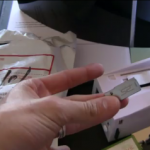Weekly News Roundup (22 August 2010)
Another very light news week, and I was too preoccupied with other stuff to have time to make up some news, so basically, there’s not much to talk about. Which means I will have to go on one of my long, pointless rants until the required word count is reached, which is funny, because I’m not paid by the word (nor am I actually paid).
I shall start the ranting even before we get to the WNR proper, and it’s something I’ve rarely covered here: politics. Okay, I’ve covered plenty of politics, since unfortunately, the Copyright Crusade™ has become very much a political issue, although one that seems to receive bipartisan support. But today, I shall talk about the elections in Australia, and the result which leaves the future of the National Broadband Network in the air. I didn’t really want to talk about the elections before the actual voting, since this is not what this blog is about, and I’ve talked about the NBN before and the benefits it would bring, such as a truly on demand video service, which could go a long way in fighting the piracy problem. The NBN plans to bring Fibre to the Premise to 93% of Australian homes, to provide up to 100 Mbps for all, with wireless and satellite of at least 12 Mbps to take care of the rest of the 7%. The opposition to the NBN has mostly been about the cost of the project, and also with some objecting to the need for faster broadband, so I thought I would outline some of the reasons why I support the NBN:
- Cost: $27 billion, over 8 years, in tax payer contributions, not $43 billion. Contributions will be earned back with interest under the NBN Co’s projections, so effective cost to tax payers is $0 for infrastructure that lasts for decades and decades. The $27 billion represents just 0.3% of the GDP over the 8 year build cycle of the NBN. As a comparison, Australia spends $27 billion per year on supporting a defence force with only 55,000 active personnel. And while the opposition has concentrated their attacks on the cost of the project, hardly anyone has attacked the value of the project – in other words, if the NBN could be built for cheaper, hardly nobody would be in opposition to it. Since the trial rollout is current under budget, the cost may very well be reduced, since the rollout process is very much a repeatable process.
- Current Internet Access: Australia currently ranks 50th in terms of broadband speed in the world, below even New Zealand. This is for those that actually have access to ADSL, as there are 1.2 million pair gain or RIM affected lines that can’t access ADSL (no direct copper connection to exchange). RIMs, mostly located in new housing estates, do not have enough ports to provide ADSL to all homes that it services, and for those that it does, congestion means sub 1 Mbps speeds in peak times. Internet access in the bush is even more pathetic.
- International Backhaul: Critics of the NBN say that having fast local speeds won’t matter if the International link is insufficient, and they’re right. Except Australia’s link to the rest of the world is more than sufficient. And increased local speeds will mean much content will be cached locally, which reduces the need to use International links.
- Applications: In terms of current services, even accessing Google Maps and YouTube proves difficult for those in the broadband blackspot areas. 720p IPTV requires 4 Mbps for decent-ish video, with 1080p requiring, in my opinion anyway, at least 8 Mbps, preferably 12 Mbps. With IPTV, TV networks would no longer be locked to the limited number of stations they current broadcast on, bringing television into the 21st century. I also work from home, and having adequate broadband would allow many other Australians to equally work from home, thus saving employers money and helping the environment as well by reducing congestion on roads. Cloud hosting will also help software companies fight piracy. As will “DVD/Blu-ray on demand” type services, which also keeps your “video library” floating in the cloud, ready for access at any time (anywhere), which helps with storage and also casual piracy. Those that read this feature will know I’ve long been a proponent of such a system. And of course there are those applications that will only invent itself after the network is in place, much like how YouTube came about, not when people were still using dialup, but when broadband speeds had reached a certain acceptable level.
- Alternatives: Wireless is dubbed an alternative to fibre, but the reality is that a shared service will never completely service the wide land that is Australia. Existing 3G and almost-4G services in Australia are already heavily congested. And any system that still relies on the quickly deteriorating copper network has no positive long term outlook. Relying on a private rollout is also infeasible, since the large geographical area of Australia, and the relatively low population, means no single company can afford to rollout fiber in the scale of the NBN, even if the business case is sound. Private companies would not look out for the national interest, and some will argue nor should they. The current unacceptable state of broadband (which both major political parties agree, that the current situation is unacceptable) has much to do with relying too much on privately owned infrastructure, and if private industry hasn’t come up with a solution 15 years since the Internet went mainstream, they are unlikely to ever come up with one.
- Filter: The most controversial aspect of the proposed NBN is the proposed filter that also comes with it, blocking out indecent content, and possibly piracy related resources. The filter was always unlikely to pass through the senate, and given current election results, it’s unlikely to even pass through the lower house, so it’s pretty much dead. Which is good to see.
Anyway, in short, the NBN is good. And hopefully it will still be built. Let’s get on with the rest of the WNR now.

Starting with the copyright news, is piracy really bad, or does it actually help content owners. I’ve asked this question many times here, and I can only conclude that there is a positive side to piracy, and content owners are well aware of it (see Viacom vs YouTube, and how Viacom employees allegedly pirated their own stuff for promotional reasons).
So it was interesting to read that the CEO of one of the largest porn companies in the world say that piracy may be a good thing. Pirated adult videos is even more of a problem than mainstream videos, because by their nature, they’re very attractive, and paying isn’t always viable (if someone else has access to your credit card bills, for example). Private Media Group CEO Berth Milton says that he not only accepts piracy exists, and he actually welcomes it, thanks to increased promotion. He also talks about selling things that aren’t easy to pirate, like physical objects. This is a topic I’ve been thinking about lately (no, not porn or porn related accessories), is that even with the dangers of going completely digital (ie. making things easier to pirate), not more is done to create a more balanced product. Remember when DVDs first came out and they all came with booklets with chapter stops and information about the movie, and then the booklet became a single sheet, still with the chapter stops, and now, there’s nothing inside the box except ads and sometimes an anti-piracy leaflet. A value added physical object, that is much harder to pirate, has been removed and studios wonder why piracy is up?

Lost: The Complete Collection on Blu-ray looks very tasty indeed, and all those goodies means it's hard to pirate the complete experience
I’ve long been an advocate of all digital distribution, but physical distribution still has its merits and will have a place in the “new world order”. And I would definitely like to see more unique physical products accompany digital music, movies and games. Games instruction booklets are so thin these days, there’s barely any explanation of the sometimes quite wonderful storyline. Sure, you’ll get to know the story when you play the game, but perhaps a little additional content, some back story, would help gamers get into the mood better, perhaps. And it’s good that collector’s editions now usually feature physical collectibles, but I think even the standard releases could use some more printed content and other things that are harder to pirate. This is definitely one way to compete with digital piracy. On that topic, I should mention the most excellent Lost Complete Collection Blu-ray, which I will talk about more in the HD/3D/Blu-ray section below.
Another way to fight piracy is to just give the content away, legally. Well not exactly give away, but ad-supported or subscription services like Spotify may just be another way to combat music piracy. A new poll shows that users of Spotify and related services are pirating much less music, and some have completely stopped. Ad-supported content sometimes do work, but most of the time, it’s hard to cover costs, let alone make a profit. Subscriptions do make more sense, because the discovery element of music means that it’s awfully expensive to legally purchase everything you want to listen to. Many have theorized, and it’s backed up by some stats, that a lot of people pirating music are only doing it so they can sample a new artist’s work, and many eventually end up paying not only for CDs, but concerts and more. And one of the best things about the digital revolution is improved access, and people want access without the current cost associated with it, and Spotify and other music services provide this without promoting piracy. I think the same model could work for video, because I see people recommending TV shows all the time, and I wonder how many are actually buying the DVDs just to check it out, and how many are following up on these recommendations by pirating the shows. Which is why Hulu is so successful I guess, but unfortunately, it’s only available in the US.
And last week I posted in the forum, but not here, about Google going Evil, the Google, Verizon Net Neutrality deal, or how Google learned to stop being so nice and love their corporate power. I didn’t post it here because, while there are copyright implication, it wasn’t so clear cut. But with the RIAA wading into the debate, it is now definitely more clear cut. The RIAA wants to use the deal as a platform to get ISPs to do more about piracy, with incentives (does not getting sued count as an incentive?). The RIAA, and the cohorts, are about the only people happy with the Google/Verizon deal, which is just so typical, really.
There’s more about piracy in the gaming section below, in regards to a surprising development for the PS3. But before we get to that …

In 3D/HD/Blu-ray news, the news I posted about Star Wars on Blu-ray didn’t include a firm release date. It’s believed that October 2011 is when we can expect the trilogy (both the good and bad one) to come on Blu-ray. That still sounds like a long time though, but if it means a superior transfer, perhaps all the various editions of the film seamlessly branched, and new bonus content, and maybe a Lost style package (see below), then the wait have been worth it.
Speaking of Lost, the complete Blu-ray collection is available to pre-order on Amazon (please click link to buy if you want to buy from Amazon, to help out this humble, unpaid, blogger). I saw it being promoted on Jimmy Kimmel, and it really impressed me, and I’ve seen a few special editions in my time. Puzzles, black light, hidden content (did Matthew Fox say hidden discs?) – it all sounds like a fun package. And the best thing is that the price isn’t totally crazy either, currently less than $150 (Corrections: It’s $150 for the DVD version, just under $195 for the Blu-ray version) for all six seasons of Lost (that’s 5074 minutes of prime time TV), plus all the goodies. Well, it’s better than that Lord of the Rings package anyway.
![]()
And moving on finally to gaming. The PS3’s status as the only next-gen console not to have been hacked for playing copied games is under threat, with perhaps the simplest hack yet. So simple, that I’m still not convinced it isn’t a hoax.
But assuming it’s real (and I think it is, thanks to new videos being posted of the hack in action), the hack involves only buying a USB drive which when plugged into the PS3, allows games to be dumped to either the internal or external HDDs. And copied games can then be played back, and all of this is done with the latest firmware. Sony is said to be aware of the hack, so expect the next firmware to quickly plug the hole, but perhaps the USB drive can be software upgraded to defeat then next firmware update (or users can stick with 3.41, and resist upgrading). And so on and so on. It’s bad news for people not interested in piracy (or playing their backed up games), as this will mean more Sony firmware, which may equal more upgrading pain. It is ironic though that the hardest to break console requires the easiest to implement hacking solution in the end, although we’ll see how Sony fights this with their firmware updates.
And that was that. A very top heavy rant-astic edition of the WNR this week. See you next week.



